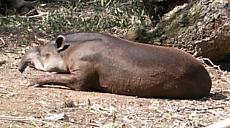Tapir
|
|
| Tapirs | ||||||||||||
|---|---|---|---|---|---|---|---|---|---|---|---|---|
 Brazilian Tapir | ||||||||||||
| Scientific classification | ||||||||||||
| ||||||||||||
| Species | ||||||||||||
|
Tapirus bairdii - Baird's Tapir |
The tapirs are large, browsing animals, roughly pig-like in shape but with a short, prehensile trunk. Size varies between species, but most are about 2 metres long, stand about a metre high at the shoulder, and weigh between 150 and 300 kg.
The tapir family is old by mammalian standards: the earliest fossil tapir dates to the early Oligocene, and Eocene rocks from as long as 55 million years ago contain a wide range of tapir-like animals. Their closest relatives are the other odd-toed ungulates: horses and rhinoceroses.
Although tapirs were once widespread, only four species endured into the modern world: three in Central and the warmer parts of South America and one in Southeast Asia.
Tapirs are forest animals that love water. Although they frequently live in dryland forest, tapirs with access to lakes or rivers spend a good deal of time in and under the water, feeding on soft marine vegetation and taking refuge from predators. The Brazilian Tapir often sinks to the bottom of a stream and walks along the riverbed to feed. In forests, they eat fruit, leaves, and berries.
The three lowland tapirs are largely nocturnal and crepuscular. The smaller Mountain Tapir of the Andes is generally diurnal, but all four species react to hunting pressure by retreating deeper into inaccessible regions and becoming more nocturnal.
Although they are taken by tigers and other big cats, bears, crocodiles, and anaconda, the tapirs' major predators are human. Hunting for meat and hides has substantially reduced their numbers and, more recently, massive habitat loss has resulted in the conservation watch-listing of all four species: the Brazilian Tapir is classified as lower risk, near threatened; both Baird's and the Malayan Tapir (which may exist in Borneo) are classified as vulnerable; and the Mountain Tapir is endangered. It is said that some kind of tapir lives in some unexplored places in inner China, but this has not been proven.
Cultural References
In Chinese, Korean and Japanese, the tapir is named after a beast from Chinese mythology. A feature of this mythical creature is a snout like that of an elephant and it is said to eat people's dreams. In Chinese the name of this beast, subsequently the name of the tapir, is min Mandarin and mek in Cantonese (貘). The Korean equivalent is maek (맥), while it is called baku (バク) in Japanese.

